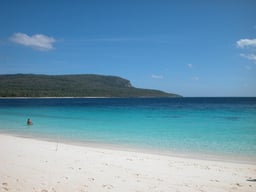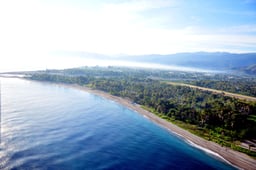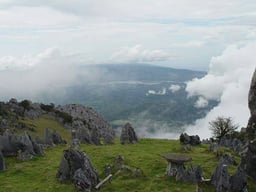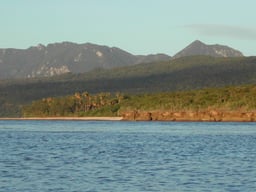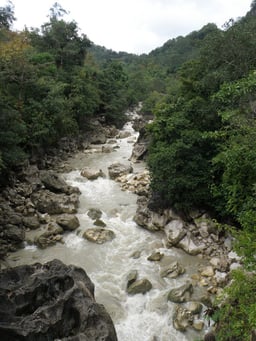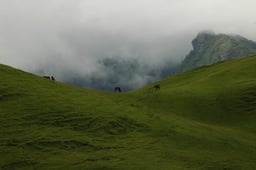East Timor
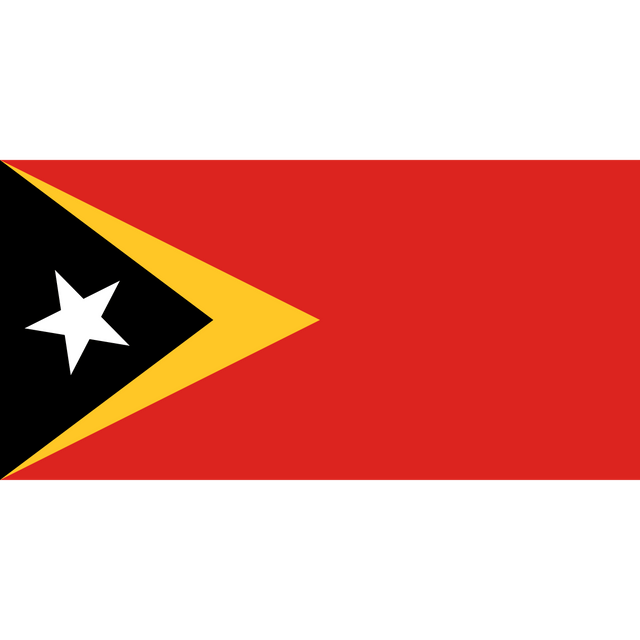
East Timor

Democratic Republic of Timor-Leste
| |
|---|---|
**Motto:**Unidade, Acção, Progresso(Portuguese) Unidade, Asaun, Progresu(Tetum) (English:"Unity, Action, Progress") | |
Anthem:"Pátria"(Portuguese) (English:"Fatherland") | |
 | |
 | |
| Capital and largest city | Dili 8°33′S 125°34′E [140] |
| Official languages | |
| National languages | 15 languages
|
| Religion (2010[1]) | 96.9% Roman Catholic 3.1% other religions |
| Demonym(s) | East Timorese Timorese Maubere (informal)[2][3] |
| Government | Unitary semi-presidentialconstitutional republic[4][5][6] |
• President | Francisco Guterres |
• Prime Minister | Taur Matan Ruak |
| Legislature | National Parliament |
| Independence from Indonesia | |
• Portuguese Timor | 16th century |
• Independence declared | 28 November 1975 |
• Annexation by Indonesia | 17 July 1976 |
• Administered by UNTAET | 25 October 1999 |
• Independence restored | 20 May 2002 |
| Area | |
• Total | 15,007[7] km2(5,794 sq mi) (154th) |
• Water (%) | negligible |
| Population | |
• 2015 census | 1,167,242[8] |
• Density | 78/km2(202.0/sq mi) |
| GDP(PPP) | 2019 estimate |
• Total | $7.221 billion |
• Per capita | $5,561[9] |
| GDP(nominal) | 2019 estimate |
• Total | $3.145 billion |
• Per capita | $2,422[9] |
| HDI(2017) | medium · 132nd |
| Currency | United States dollarb(USD) |
| Time zone | UTC+9 |
| Driving side | left |
| Calling code | +670 |
| ISO 3166 code | TL |
| Internet TLD | .tlc |
| |
East Timor (/-ˈtiːmɔːr/ (listen)) or Timor-Leste (/tiˈmɔːr ˈlɛʃteɪ/; Tetum: Timór Lorosa'e), officially the Democratic Republic of Timor-Leste[11] (Portuguese: República Democrática de Timor-Leste,[12] Tetum: Repúblika Demokrátika Timór-Leste),[13] is a country in Maritime Southeast Asia.[14] It comprises the eastern half of the island of Timor, the nearby islands of Atauro and Jaco, and Oecusse, an exclave on the northwestern side of the island surrounded by Indonesian West Timor. Australia is the country's southern neighbour, separated by the Timor Sea. The country's size is about 15,007 km2 (5,794 sq mi).[7]
East Timor was colonised by Portugal in the 16th century, and was known as Portuguese Timor until 28 November 1975, when the Revolutionary Front for an Independent East Timor (Fretilin) declared the territory's independence. Nine days later, it was invaded and occupied by the Indonesian military, and was declared as the country's 27th province the following year. The Indonesian occupation of East Timor was characterised by a highly violent, decades-long conflict between separatist groups (especially Fretilin) and the Indonesian military.
In 1999, following the United Nations-sponsored act of self-determination, Indonesia relinquished control of the territory. East Timor became the first new sovereign state of the 21st century on 20 May 2002 and joined the United Nations and the Community of Portuguese Language Countries. In 2011, East Timor announced its intention to become the eleventh member of the Association of Southeast Asian Nations (ASEAN).[15] It is one of only two predominantly Christian nations in Southeast Asia, the other being the Philippines, as well as the only Asian country to be located completely in the Southern Hemisphere.
Democratic Republic of Timor-Leste
| |
|---|---|
**Motto:**Unidade, Acção, Progresso(Portuguese) Unidade, Asaun, Progresu(Tetum) (English:"Unity, Action, Progress") | |
Anthem:"Pátria"(Portuguese) (English:"Fatherland") | |
 | |
 | |
| Capital and largest city | Dili 8°33′S 125°34′E [140] |
| Official languages | |
| National languages | 15 languages
|
| Religion (2010[1]) | 96.9% Roman Catholic 3.1% other religions |
| Demonym(s) | East Timorese Timorese Maubere (informal)[2][3] |
| Government | Unitary semi-presidentialconstitutional republic[4][5][6] |
• President | Francisco Guterres |
• Prime Minister | Taur Matan Ruak |
| Legislature | National Parliament |
| Independence from Indonesia | |
• Portuguese Timor | 16th century |
• Independence declared | 28 November 1975 |
• Annexation by Indonesia | 17 July 1976 |
• Administered by UNTAET | 25 October 1999 |
• Independence restored | 20 May 2002 |
| Area | |
• Total | 15,007[7] km2(5,794 sq mi) (154th) |
• Water (%) | negligible |
| Population | |
• 2015 census | 1,167,242[8] |
• Density | 78/km2(202.0/sq mi) |
| GDP(PPP) | 2019 estimate |
• Total | $7.221 billion |
• Per capita | $5,561[9] |
| GDP(nominal) | 2019 estimate |
• Total | $3.145 billion |
• Per capita | $2,422[9] |
| HDI(2017) | medium · 132nd |
| Currency | United States dollarb(USD) |
| Time zone | UTC+9 |
| Driving side | left |
| Calling code | +670 |
| ISO 3166 code | TL |
| Internet TLD | .tlc |
| |
Etymology
"Timor" derives from timur, the word for "east" in Indonesian language, which became recorded as Timor in Portuguese, thus resulting in the tautological toponym meaning "East East": In Portuguese Timor-Leste (Leste being the word for "east"); in Tetum Timór Lorosa'e (Lorosa'e being the word for "east" (literally "rising sun")). In Indonesian, the country is called Timor Timur, thereby using the Portuguese name for the island followed by the word for "east", as adjectives in Indonesian are put after the noun.
The International Organization for Standardization (ISO) official short form in English and all other languages is Timor-Leste (codes: TLS & TL), which has been adopted by the United Nations,[17] the European Union,[18] and the national standards organisations of France (AFNOR), the United States (ANSI),[19] United Kingdom (BSI), Germany (DIN), and Sweden (SIS), all diplomatic missions to the country by protocol and the CIA World Factbook.[20]
History
Prehistory
Humans first settled in East Timor 42,000 years ago.[21] Descendants of at least three waves of migration are believed still to live in East Timor. The first is described by anthropologists as people of the Veddo-Australoid type. Around 3000 BC, a second migration brought Melanesians. The earlier Veddo-Australoid peoples withdrew at this time to the mountainous interior. Finally, proto-Malays arrived from south China and north Indochina.[22] Hakka traders are among those descended from this final group.[23] Timorese origin myths tell of ancestors that sailed around the eastern end of Timor arriving on land in the south. Some stories recount Timorese ancestors journeying from the Malay Peninsula or the Minangkabau highlands of Sumatra.[24] Austronesians migrated to Timor, and are thought to be associated with the development of agriculture on the island.
Classical era

Arms of Portuguese Timor (1935–1975)[28]
Before European colonialism, Timor was included in Chinese and Indian trading networks, and in the 14th century was an exporter of aromatic sandalwood, slaves, honey, and wax. Since the 1500's, the Timorese people had military ties with the Luções of present-day northern Philippines.[25][26] It was the relative abundance of sandalwood in Timor that attracted European explorers to the island in the early 16th century.[27] During that time, European explorers reported that the island had a number of small chiefdoms or princedoms.
Colonial era
Portuguese period (1769–1975)

A demonstration for independence from Indonesia held in Australia during September 1999
The Portuguese established outposts in Timor and Maluku. Effective European occupation of a small part of the territory began in 1769, when the city of Dili was founded and the colony of Portuguese Timor declared.[29] A definitive border between the Dutch-colonised western half of the island and the Portuguese-colonised eastern half of the island was established by the Permanent Court of Arbitration of 1914,[30] and it remains the international boundary between the successor states East Timor and Indonesia. For the Portuguese, East Timor remained little more than a neglected trading post until the late nineteenth century, with minimal investment in infrastructure, health, and education. Sandalwood remained the main export crop with coffee exports becoming significant in the mid-nineteenth century. As was often the case, Portuguese rule was generally neglectful but exploitative where it existed.[31]
At the beginning of the twentieth century, a faltering home economy prompted the Portuguese to extract greater wealth from its colonies, which was met with East Timorese resistance.[31]
During World War II, first the Allies and later the Japanese occupied Dili, and the mountainous interior became the scene of a guerrilla campaign, known as the Battle of Timor. Waged by East Timorese volunteers and Allied forces against the Japanese, the struggle resulted in the deaths of between 40,000 and 70,000 East Timorese.[32] The Japanese eventually drove the last of the Australian and Allied forces out. However, following the end of World War II and Japanese surrender, Portuguese control was reinstated.
Following the 1974 Portuguese revolution, Portugal effectively abandoned its colony on Timor and civil war between East Timorese political parties broke out in 1975.
The Revolutionary Front for an Independent East Timor (Fretilin) resisted a Timorese Democratic Union (UDT) coup attempt in August 1975,[33] and unilaterally declared independence on 28 November 1975. Fearing a communist state within the Indonesian archipelago, the Indonesian military launched an invasion of East Timor in December 1975.[34] Indonesia declared East Timor its 27th province on 17 July 1976.[35] The UN Security Council opposed the invasion and the territory's nominal status in the UN remained as "non-self-governing territory under Portuguese administration".[36]
Indonesian occupation (1975–1999)

José Ramos-Horta, 1996 Nobel Peace Prize winner, second President of East Timor
Indonesia's occupation of East Timor was marked by violence and brutality. A detailed statistical report prepared for the Commission for Reception, Truth and Reconciliation in East Timor cited a minimum bound of 102,800 conflict-related deaths in the period 1974–1999, namely, approximately 18,600 killings and 84,200 "excess" deaths from hunger and illness, with an estimated figure based on Portuguese, Indonesian and Catholic Church data of approximately 200,000 deaths.[37] The East Timorese guerrilla force (Forças Armadas da Libertação Nacional de Timor-Leste, Falintil) fought a campaign against the Indonesian forces from 1975 to 1998.
The 1991 Dili Massacre was a turning point for the independence cause and an East Timor solidarity movement grew in Portugal, the Philippines, Australia, and other Western countries.
Following the resignation of Indonesian President Suharto, a UN-sponsored agreement between Indonesia and Portugal allowed for a UN-supervised popular referendum in August 1999. A clear vote for independence was met with a punitive campaign of violence by East Timorese pro-integration militia with the support of elements of the Indonesian military. With Indonesian permission, an Australian-led multi-national peacekeeping force (INTERFET) was deployed until order was restored. On 25 October 1999, the administration of East Timor was taken over by the UN through the United Nations Transitional Administration in East Timor (UNTAET).[38] The INTERFET deployment ended in February 2000 with the transfer of military command to the UN.[39]
Contemporary era
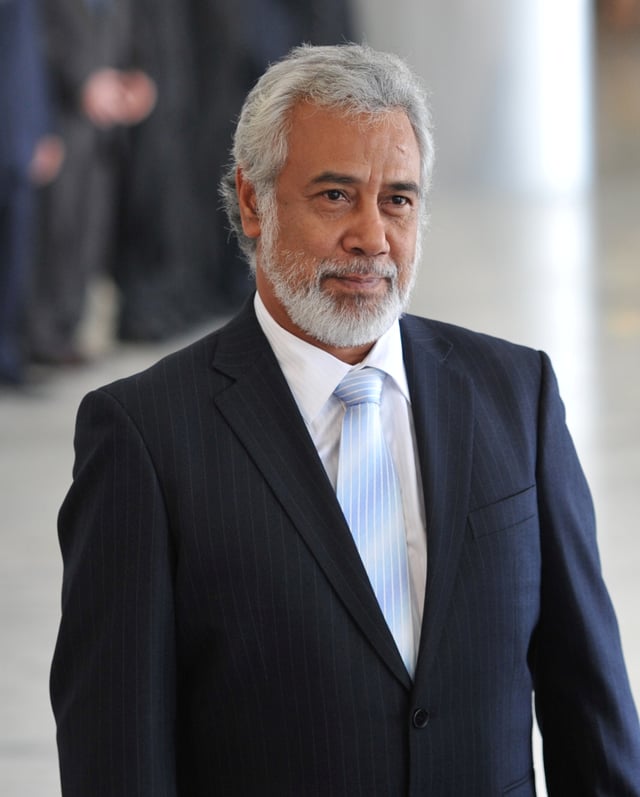
Xanana Gusmão, the first East Timorese President after Indonesian occupation.
On 30 August 2001, the East Timorese voted in their first election organised by the UN to elect members of the Constituent Assembly.[16][40] On 22 March 2002, the Constituent Assembly approved the Constitution.[16] By May 2002, over 205,000 refugees had returned.[41] On 20 May 2002, the Constitution of the Democratic Republic of East Timor came into force and East Timor was recognised as independent by the UN.[40][42] The Constituent Assembly was renamed the National Parliament and Xanana Gusmão was sworn in as the country's first President after Indonesian occupation. On 27 September 2002, East Timor was renamed to Timor-Leste, using the Portuguese language, and was admitted as a member state by the UN.[43]
The following year, Gusmão declined another presidential term, and in the build-up to the April 2007 presidential elections there were renewed outbreaks of violence. José Ramos-Horta was elected President in the May 2007 election,[44] while Gusmão ran in the parliamentary elections and became Prime Minister. Ramos-Horta was critically injured in an attempted assassination in February 2008. Prime Minister Gusmão also faced gunfire separately but escaped unharmed. Australian reinforcements were immediately sent to help keep order.[45] In 2006, the United Nations sent in security forces to restore order when unrest and factional fighting forced 15 percent of the population (155,000 people) to flee their homes. In March 2011, the UN handed over operational control of the police force to the East Timor authorities. The United Nations ended its peacekeeping mission on 31 December 2012.[46]
East Timor became a state party to the UNESCO World Heritage Convention on 31 January 2017.[47]
Politics and government
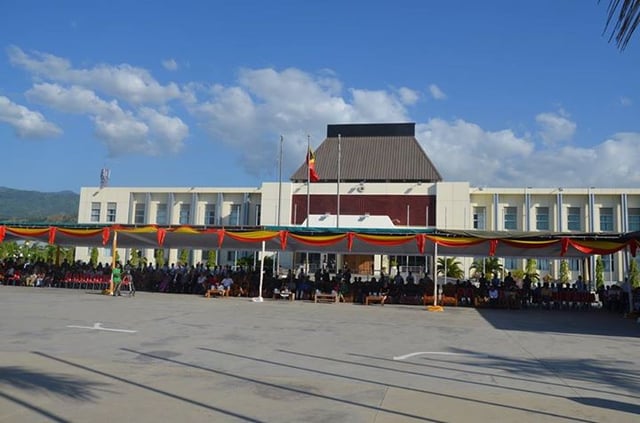
Nicolau Lobato Presidential Palace in Dili.

The National Parliament of East Timor
The head of state of East Timor is the President of the Republic, who is elected by popular vote for a five-year term. Although their executive powers are somewhat limited, the President does have the power to appoint the Prime Minister and veto government legislation. Following elections, the President usually appoints the leader of the majority party or coalition as Prime Minister of East Timor and the cabinet on the proposal of the latter. As head of government, the Prime Minister presides over the cabinet.[4][5]
The unicameral East Timorese parliament is the National Parliament or Parlamento Nacional, whose members are elected by popular vote to a five-year term. The number of seats can vary from a minimum of fifty-two to a maximum of sixty-five. The East Timorese constitution was modelled on that of Portugal. The country is still in the process of building its administration and governmental institutions. Government departments include the Polícia Nacional de Timor-Leste (police), East Timor Ministry for State and Internal Administration, Civil Aviation Division of Timor-Leste, and Immigration Department of Timor-Leste.
Administrative divisions

The thirteen municipalities of East Timor
Oecusse
Liquiçá
Dili
Manatuto
Baucau
Lautém
Bobonaro
Ermera
Aileu
Viqueque
Cova Lima
Ainaro
Manufahi
Foreign relations and military
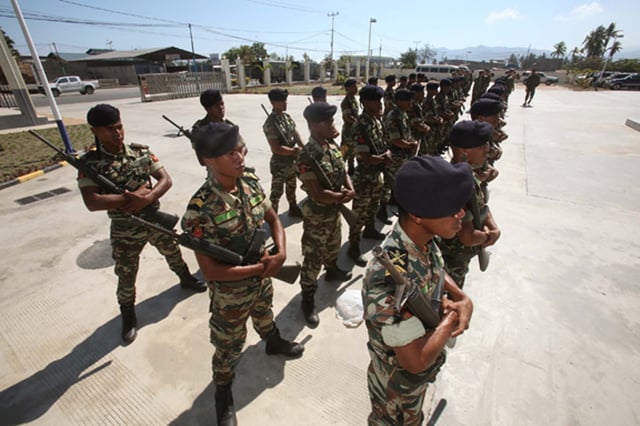
F-FDTL soldiers standing in formation

The Casa Europa in Dili, the European Union's representation in East Timor
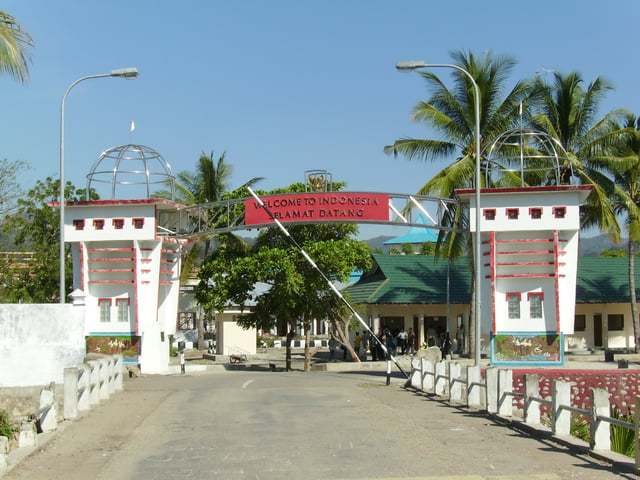
Indonesia-East Timor border in Mota'ain
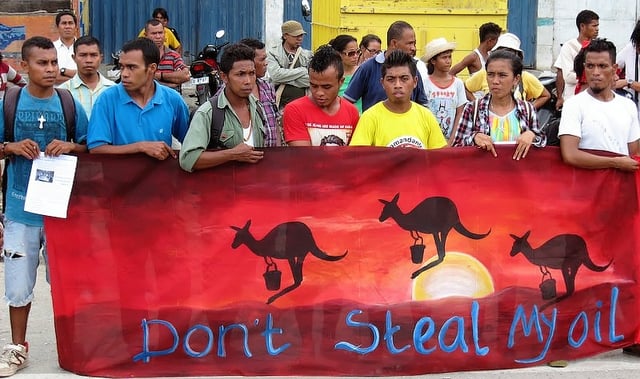
Demonstration against Australia on December 2013
East Timor is a full member state of the Community of Portuguese Language Countries (CPLP), also known as the Lusophone Commonwealth, an international organization and political association of Lusophone nations across four continents, where Portuguese is an official language. East Timor sought membership in the Association of Southeast Asian Nations (ASEAN) in 2007, and a formal application was submitted in March 2011.[50] Indonesia and the Philippines support East Timor's bid to join ASEAN.
The East Timor Defence Force (Forças de Defesa de Timor-Leste, F-FDTL) is the military body responsible for the defence of East Timor. The F-FDTL was established in February 2001 and comprised two small infantry battalions, a small naval component, and several supporting units.
The F-FDTL's primary role is to protect East Timor from external threats. It also has an internal security role, which overlaps with that of the National Police of East Timor (Polícia Nacional de Timor-Leste, PNTL). This overlap has led to tensions between the services, which have been exacerbated by poor morale and lack of discipline within the F-FDTL.
The F-FDTL's problems came to a head in 2006 when almost half the force was dismissed following protests over discrimination and poor conditions. The dismissal contributed to a general collapse of both the F-FDTL and PNTL in May and forced the government to request foreign peacekeepers to restore security. The F-FDTL is being rebuilt with foreign assistance and has drawn up a long-term force development plan.
Since the discovery of petroleum in the Timor Sea in the 1970s, there have been disputes surrounding the rights to ownership and exploitation of the resources situated in a part of the Timor Sea known as the Timor Gap, which is the area of the Timor Sea which lies outside the territorial boundaries of the nations to the north and south of the Timor Sea.[51] These disagreements initially involved Australia and Indonesia, although a resolution was eventually reached in the form of the Timor Gap Treaty. After declaration of East Timor's nationhood in 1999, the terms of the Timor Gap Treaty were abandoned and negotiations commenced between Australia and East Timor, culminating in the Timor Sea Treaty.
Australia's territorial claim extends to the bathymetric axis (the line of greatest sea-bed depth) at the Timor Trough. It overlaps East Timor's own territorial claim, which follows the former colonial power Portugal and the United Nations Convention on the Law of the Sea in claiming that the dividing line should be midway between the two countries.
It was revealed in 2013 that the Australian Secret Intelligence Service (ASIS) planted listening devices to listen to the East Timorese government during negotiations over the Greater Sunrise oil and gasfields. This is known as the Australia–East Timor spying scandal.[52]
Geography
Located in Southeast Asia,[53] the island of Timor is part of Maritime Southeast Asia, and is the largest and easternmost of the Lesser Sunda Islands. To the north of the island are the Ombai Strait, Wetar Strait, and the greater Banda Sea. The Timor Sea separates the island from Australia to the south, and the Indonesian Province of East Nusa Tenggara lies to East Timor's west. The total land size is 14,919 km2 (5,760 sq mi). East Timor has an exclusive economic zone of 70,326 km2 (27,153 sq mi).[54]
Much of the country is mountainous, and its highest point is Tatamailau (also known as Mount Ramelau) at 2,963 metres (9,721 ft).[55] The climate is tropical and generally hot and humid. It is characterised by distinct rainy and dry seasons. The capital, largest city, and main port is Dili, and the second-largest city is the eastern town of Baucau. East Timor lies between latitudes 8° and 10°S, and longitudes 124° and 128°E.
The easternmost area of East Timor consists of the Paitchau Range and the Lake Ira Lalaro area, which contains the country's first conservation area, the Nino Konis Santana National Park.[56] It contains the last remaining tropical dry forested area within the country. It hosts a number of unique plant and animal species and is sparsely populated.[57] The northern coast is characterised by a number of coral reef systems that have been determined to be at risk.[58]
Economy

East Timor export treemap, 2010
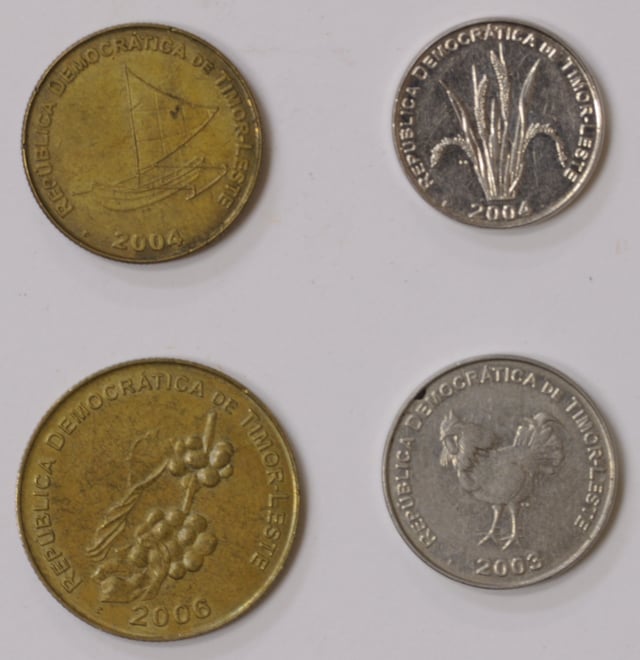
Fractional coins "centavos"
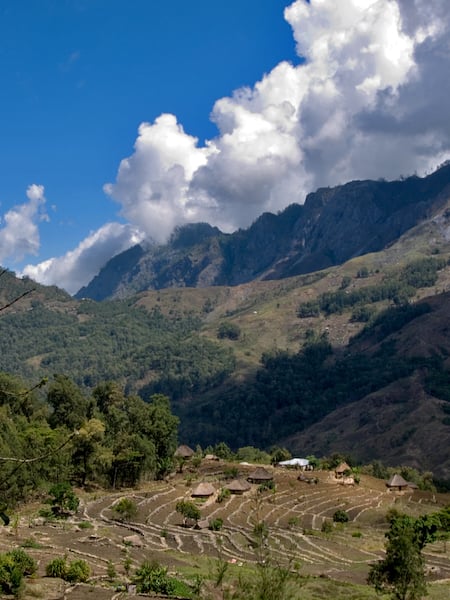
Coffee plantations in Aileu
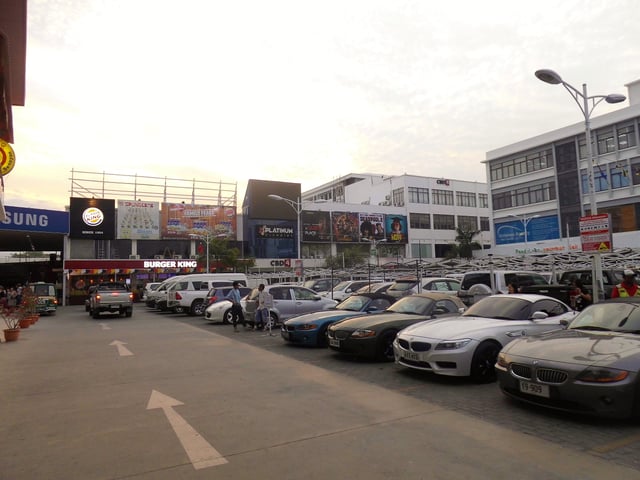
Shopping mall in Dili
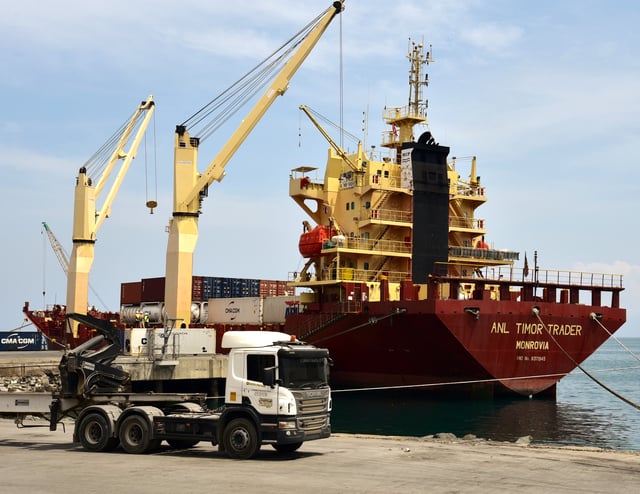
Port of Dili
The Timor-Leste Petroleum Fund was established in 2005, and by 2011 it had reached a worth of US$8.7 billion.[62] East Timor is labelled by the International Monetary Fund as the "most oil-dependent economy in the world".[63] The Petroleum Fund pays for nearly all of the government's annual budget, which has increased from $70 million in 2004 to $1.3 billion in 2011, with a $1.8 billion proposal for 2012.[62] East-Timor's income from oil and gas stands to significantly increase after its announcement to cancel a controversial agreement with Australia, which has given Australia half of the income from oil and gas since 2006.[64]
The economy is dependent on government spending and, to a lesser extent, assistance from foreign donors.[65] Private sector development has lagged due to human capital shortages, infrastructure weakness, an incomplete legal system, and an inefficient regulatory environment.[65] After petroleum, the second largest export is coffee, which generates about $10 million a year.[65] Starbucks is a major purchaser of East Timorese coffee.[66]
9,000 tonnes of coffee, 108 tonnes of cinnamon and 161 tonnes of cocoa were harvested in 2012 making the country the 40th ranked producer of coffee, the 6th ranked producer of cinnamon and the 50th ranked producer of cocoa worldwide.[67]
According to data gathered in the 2010 census, 87.7% of urban (321,043 people) and 18.9% of rural (821,459 people) households have electricity, for an overall average of 38.2%.[68]
The agriculture sector employs 80% of the active population.[69] In 2009, about 67,000 households grew coffee in East Timor, with a large proportion being poor.[69] Currently, the gross margins are about $120 per hectare, with returns per labour-day of about $3.70.[69] There were 11,000 households growing mungbeans as of 2009, most of them subsistence farmers.[69]
The country was ranked 169th overall and last in the East Asia and Pacific region by the Doing Business 2013 report by the World Bank. The country fared particularly poorly in the "registering property", "enforcing contracts" and "resolving insolvency" categories, ranking last worldwide in all three.[70]
As regards telecommunications infrastructure, East Timor is the second to last ranked Asian country in the World Economic Forum's Network Readiness Index (NRI), with only Myanmar falling behind it in southeast Asia. NRI is an indicator for determining the development level of a country's information and communication technologies. East Timor ranked number 141 overall in the 2014 NRI ranking, down from 134 in 2013.[71]
The Portuguese colonial administration granted concessions to the Australia-bound Oceanic Exploration Corporation to develop petroleum and natural gas deposits in the waters southeast of Timor. However, this was curtailed by the Indonesian invasion in 1976. The resources were divided between Indonesia and Australia with the Timor Gap Treaty in 1989.[72] East Timor inherited no permanent maritime boundaries when it attained independence. A provisional agreement (the Timor Sea Treaty, signed when East Timor became independent on 20 May 2002) defined a Joint Petroleum Development Area (JPDA) and awarded 90% of revenues from existing projects in that area to East Timor and 10% to Australia.[73] An agreement in 2005 between the governments of East Timor and Australia mandated that both countries put aside their dispute over maritime boundaries and that East Timor would receive 50% of the revenues from the resource exploitation in the area (estimated at A$26 billion, or about US$20 billion over the lifetime of the project)[74] from the Greater Sunrise development.[75] In 2013, East Timor launched a case at the Permanent Court of Arbitration in The Hague to pull out of a gas treaty that it had signed with Australia, accusing the Australian Secret Intelligence Service (ASIS) of bugging the East Timorese cabinet room in Dili in 2004.[76] East Timor is part of the Timor Leste–Indonesia–Australia Growth Triangle (TIA-GT).[77]
There are no patent laws in East Timor.[78]
A railway system has been proposed but the current government has yet to approve the proposal due to lack of funds and expertise. If established, the country's economy is projected to have an economic boom similar to that of Japan almost a century ago. The Philippines has noted that if they finally finish their own railway system by 2022, they may send experts and aid to East Timor for its railway ambitions.
Demographics
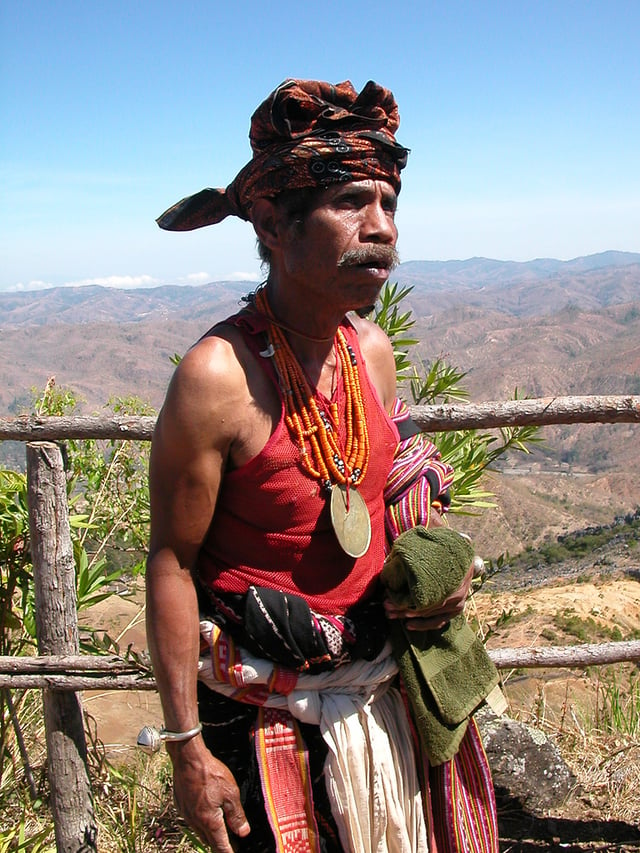
An East Timorese in traditional dress

Population pyramid
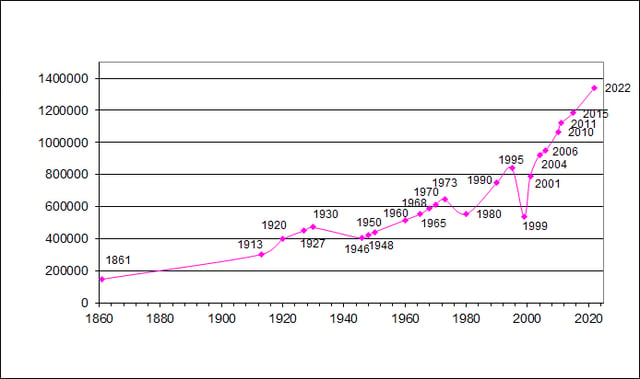
East Timor demographic change between 1861 and 2010.
| Historical populations | ||
|---|---|---|
| Year | Pop. | ±% |
| 1980 | 555,350 | — |
| 1990 | 747,557 | +34.6% |
| 2001 | 787,340 | +5.3% |
| 2004 | 923,198 | +17.3% |
| 2010 | 1,066,582 | +15.5% |
| 2015 | 1,167,242 | +9.4% |
| Source: 2015 census[79] | ||
East Timor recorded a population of 1,167,242 in its 2015 census.[8]
The word Maubere,[84] formerly used by the Portuguese to refer to native East Timorese and often employed as synonymous with the illiterate and uneducated, was adopted by Fretilin as a term of pride.[85] Native East Timorese consist of a number of distinct ethnic groups, most of whom are of mixed Austronesian and Melanesian/Papuan descent. The largest Malayo-Polynesian ethnic groups are the Tetum[86] (100,000), primarily in the north coast and around Dili; the Mambai (80,000), in the central mountains; the Tukudede (63,170), in the area around Maubara and Liquiçá; the Galoli (50,000), between the tribes of Mambae and Makasae; the Kemak (50,000) in north-central Timor island; and the Baikeno (20,000), in the area around Pante Macassar.
The main tribes of predominantly Papuan origin include the Bunak (84,000), in the central interior of Timor island; the Fataluku (40,000), at the eastern tip of the island near Lospalos; and the Makasae (70,000), toward the eastern end of the island. As a result of interracial marriage which was common during the Portuguese era, there is a population of people of mixed East Timorese and Portuguese origin, known in Portuguese as mestiços. There is a small Chinese minority, most of whom are Hakka.[87] Many Chinese left in the mid-1970s.[88]
Languages
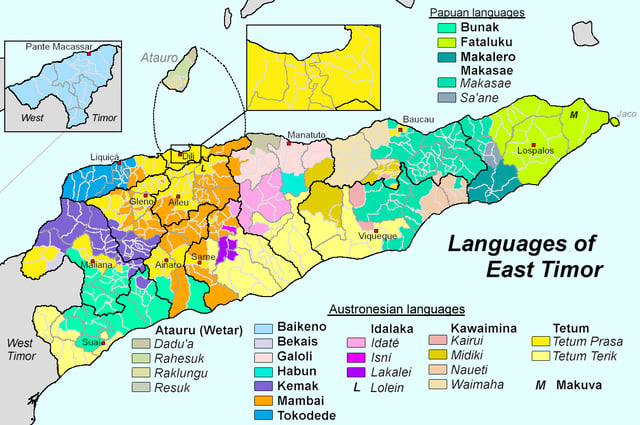
Major language groups in East Timor by suco
East Timor's two official languages are Portuguese and Tetum. English and Indonesian are sometimes used.[89] Tetum belongs to the Austronesian family of languages spoken throughout Southeast Asia and the Pacific.[90]
The 2010 census found that the most commonly spoken mother tongues were Tetum Prasa (mother tongue for 36.6% of the population), Mambai (12.5%), Makasai (9.7%), Tetum Terik (6.0%), Baikenu (5.9%), Kemak (5.9%), Bunak (5.3%), Tokodede (3.7%), and Fataluku (3.6%). Other indigenous languages largely accounted for 10.9%, while Portuguese was spoken natively by the remainder.[91]
Under Indonesian rule, the use of Portuguese was banned, and even criminalized with the death penalty[92] and only Indonesian was allowed to be used in government offices, schools and public business.[93] During the Indonesian occupation, Tetum and Portuguese were important unifying elements for the East Timorese people in opposing Javanese culture.[94] Portuguese was adopted as one of the two official languages upon independence in 2002 for this reason and as a link to Lusophone nations in other parts of the world. It is now being taught and promoted with the help of Brazil, Portugal, and the Community of Portuguese Language Countries.[95]
According to the observatory of the Portuguese language, the East Timorese literacy rate was 77.8% in Tetum, 55.6% in Indonesian, and 39.3% in Portuguese, and that the primary literacy rate increased from 73% in 2009 to 83% in 2012.[92] Indonesian and English are defined as working languages under the Constitution in the Final and Transitional Provisions, without setting a final date. In 2012, 35% could speak, read, and write Portuguese, which is up significantly from less than 5% in the 2006 UN Development Report. Portuguese is recovering as it is now been made the main official language of Timor, and is being taught in most schools.[89][96] It is estimated that English is understood by 31.4% of the population. East Timor is a member of the Community of Portuguese Language Countries (also known as the Lusophone Commonwealth) and of the Latin Union.[97]
Aside from Tetum, Ethnologue lists the following indigenous languages: Adabe, Baikeno, Bunak, Fataluku, Galoli, Habun, Idaté, Kairui-Midiki, Kemak, Lakalei, Makasae, Makuv'a, Mambae, Nauete, Tukudede, and Waima'a.[98] According to the Atlas of the World's Languages in Danger, there are six endangered languages in East Timor: Adabe, Habu, Kairui-Midiki, Maku'a, Naueti, and Waima'a.[99]
Education
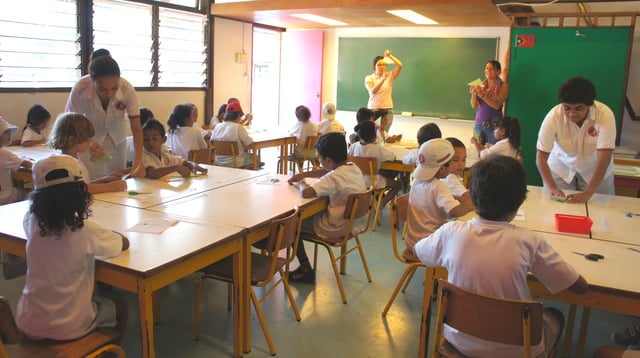
Escola Portuguesa Ruy Cinatti, the Portuguese School of Díli.
The National University of East Timor is the country's main university. There are also four colleges.[102]
Since independence, both Indonesian and Tetum have lost ground as media of instruction, while Portuguese has increased: in 2001 only 8.4% of primary school and 6.8% of secondary school students attended a Portuguese-medium school; by 2005 this had increased to 81.6% for primary and 46.3% for secondary schools.[103] Indonesian formerly played a considerable role in education, being used by 73.7% of all secondary school students as a medium of instruction, but by 2005 it was used by most schools in Baucau, Manatuto, as well as the capital district. The Philippines has sent Filipino teachers to East Timor to teach English, so that a program between the two countries can begin, where deserving English-knowledgeable East Timorese nationals will be granted university scholarships in the Philippines.[103]
Health
See Health in East Timor
Religion
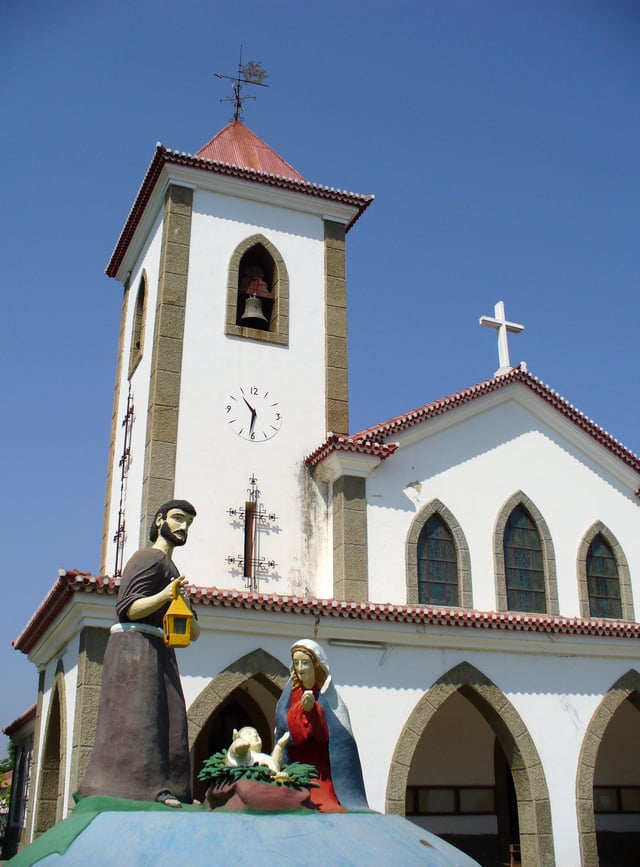
The Church of Santo António de Motael, Dili
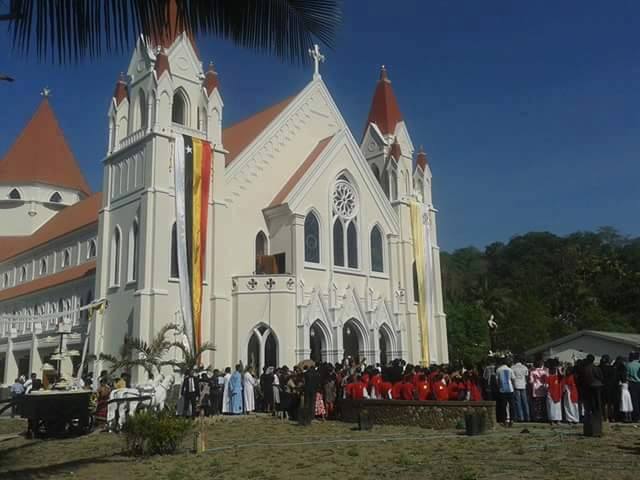
Igreja da Imaculada Conceição church, in Viqueque
According to the 2010 census, 96.9% of the population is Roman Catholic; 2.2% Protestant; 0.3% Muslim; and 0.5% practice some other or no religion.[1] A 2016 survey conducted by the Demographic and Health Survey programme showed that Catholics made up 98.3% of the population, Protestants 1.2%, and Muslims 0.3%.[104]
The number of churches has grown from 100 in 1974 to over 800 in 1994,[102] with Church membership having grown considerably under Indonesian rule as Pancasila, Indonesia's state ideology, requires all citizens to believe in one God and does not recognise traditional beliefs. East Timorese animist belief systems did not fit with Indonesia's constitutional monotheism, resulting in mass conversions to Christianity. Portuguese clergy were replaced with Indonesian priests and Latin and Portuguese mass was replaced by Indonesian mass.[105] While just 20% of East Timorese called themselves Catholics at the time of the 1975 invasion, the figure surged to reach 95% by the end of the first decade after the invasion.[105][106] In rural areas, Roman Catholicism is syncretized with local animist beliefs.[107] With over 95% Catholic population, East Timor is currently one of the most densely Catholic countries in the world.[108]
The number of Protestants and Muslims declined significantly after September 1999 because these groups were disproportionately represented among supporters of integration with Indonesia and among the Indonesian civil servants assigned to work in the province from other parts of Indonesia, many of whom left the country in 1999.[109] There are also small Protestant and Muslim communities.[109] The Indonesian military forces formerly stationed in the country included a significant number of Protestants, who played a major role in establishing Protestant churches in the territory.[109] Fewer than half of those congregations existed after September 1999, and many Protestants were among those who remained in West Timor.[109] The Assemblies of God is the largest and most active of the Protestant denominations.[109]
While the Constitution of East Timor enshrines the principles of freedom of religion and separation of church and state in Section 45 Comma 1, it also acknowledges "the participation of the Catholic Church in the process of national liberation" in its preamble (although this has no legal value).[110] Upon independence, the country joined the Philippines to become the only two predominantly Roman Catholic states in Asia, although nearby parts of eastern Indonesia such as West Timor and Flores also have Roman Catholic majorities.
The Roman Catholic Church divides East Timor into three dioceses: the Diocese of Díli, the Diocese of Baucau, and the Diocese of Maliana, all of which have friendly ties with the hundreds of dioceses in the Philippines.[111]
Culture
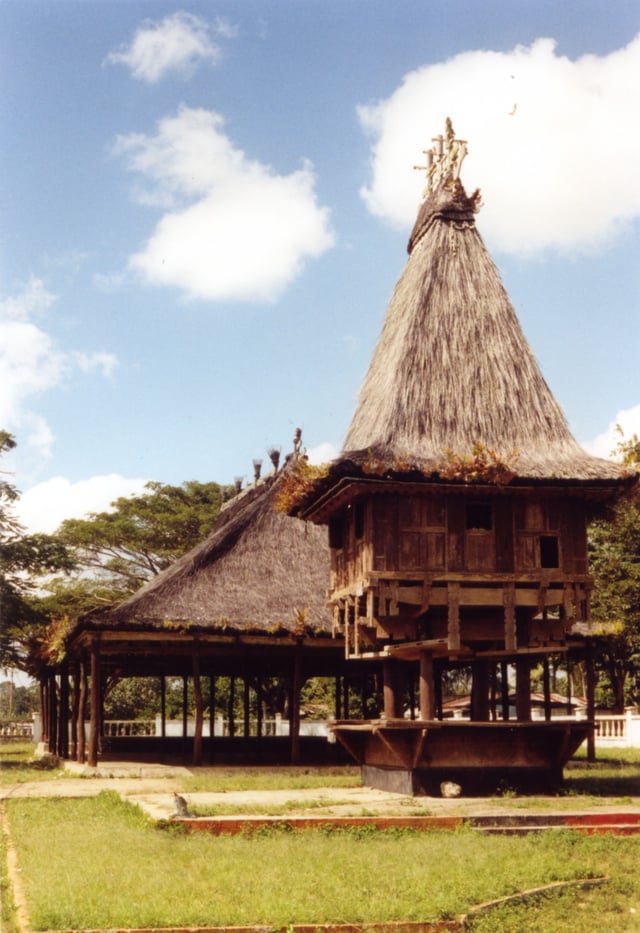
Sacred house (lee teinu) in Lospalos
The culture of East Timor reflects numerous influences, including Portuguese, Roman Catholic and Indonesian, on Timor's indigenous Austronesian and Melanesian cultures. East Timorese culture is heavily influenced by Austronesian legends. For example, East Timorese creation myth has it that an aging crocodile transformed into the island of Timor as part of a debt repayment to a young boy who had helped the crocodile when it was sick.[112][113] As a result, the island is shaped like a crocodile and the boy's descendants are the native East Timorese who inhabit it. The phrase "leaving the crocodile" refers to the pained exile of East Timorese from their island. East Timor is currently finalizing its dossiers needed for nominations in the UNESCO World Heritage List, UNESCO Intangible Cultural Heritage Lists, UNESCO Creative Cities Network, UNESCO Global Geoparks Network, and UNESCO Biosphere Reserve Network. The country currently has one document in the UNESCO Memory of the World Register, namely, On the Birth of a Nation: Turning points.[114]
Arts

Traditional Timorese dancers
Architecturally, Portuguese-style buildings can be found, along with the traditional totem houses of the eastern region. These are known as uma lulik ("sacred houses") in Tetum and lee teinu ("legged houses") in Fataluku. Craftsmanship and the weaving of traditional scarves (tais) is also widespread.
An extensive collection of Timorese audiovisual material is held at the National Film and Sound Archive of Australia. These holdings have been identified in a document titled The NFSA Timor-Leste Collection Profile, which features catalogue entries and essays for a total of 795 NFSA-held moving image, recorded sound and documentation works that have captured the history and culture of East Timor since the early 20th century.[117] The NFSA is working with the East Timorese government to ensure that all of this material can be used and accessed by the people of that country.[118]
Cinema and TV drama
In 2009 and 2010, East Timor was the setting for the Australian film Balibo and the South Korean film A Barefoot Dream. In 2013, the first East Timorese feature film, Beatriz's War, was released.[119] Two further feature-length films, Abdul & José and Ema Nudar Umanu, were respectively released on July 30, 2017 through the television network of RTTF[120][121] and on August 16, 2018 at the Melbourne International Film Festival.[122] In 2010, the first East Timorese TV drama, Suku Hali was released.
Cuisine
The cuisine of East Timor consists of regional popular foods such as pork, fish, basil, tamarind, legumes, corn, rice, root vegetables, and tropical fruit. East Timorese cuisine has influences from Southeast Asian cuisine and from Portuguese dishes from its colonisation by Portugal. Flavours and ingredients from other former Portuguese colonies can be found due to the centuries-old Portuguese presence on the island. Due to the East and West combination of East Timor's cuisine, it developed features related to Filipino cuisine, which also experienced an East-West culinary combination.
Sports
Sports organisations joined by East Timor include the International Olympic Committee (IOC), the International Association of Athletics Federations (IAAF), the International Badminton Federation (IBF), the Union Cycliste Internationale, the International Weightlifting Federation, the International Table Tennis Federation (ITTF), the International Basketball Federation (FIBA), and East Timor's national football team joined FIFA. East Timorese athletes competed in the 2003 Southeast Asian Games held 2003. In the 2003 ASEAN Paralympics Games, East Timor won a bronze medal. In the Athens 2004 Olympic Games, East Timorese athletes participated in athletics, weightlifting and boxing. East Timor won three medals in Arnis at the 2005 Southeast Asian Games. East Timor competed in the first Lusophony Games and, in October 2008, the country earned its first international points in a FIFA football match with a 2–2 draw against Cambodia.[123] East Timor competed at the 2014 Winter Olympics.
See also
Outline of East Timor
Index of East Timor-related articles

